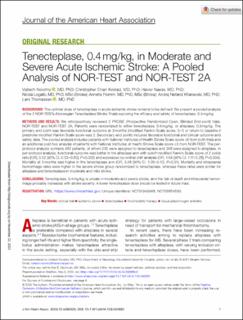| dc.contributor.author | Novotny, Vojtech | |
| dc.contributor.author | Kvistad, Christopher Elnan | |
| dc.contributor.author | Næss, Halvor | |
| dc.contributor.author | Logallo, Nicola | |
| dc.contributor.author | Fromm, Annette | |
| dc.contributor.author | Khanevski, Andrej | |
| dc.contributor.author | Thomassen, Lars | |
| dc.date.accessioned | 2024-04-19T08:48:06Z | |
| dc.date.available | 2024-04-19T08:48:06Z | |
| dc.date.created | 2023-11-15T12:52:31Z | |
| dc.date.issued | 2023 | |
| dc.identifier.issn | 2047-9980 | |
| dc.identifier.uri | https://hdl.handle.net/11250/3127371 | |
| dc.description.abstract | Background: The optimal dose of tenecteplase in acute ischemic stroke remains to be defined. We present a pooled analysis of the 2 NOR‐TESTs (Norwegian Tenecteplase Stroke Trials) exploring the efficacy and safety of tenecteplase, 0.4 mg/kg.
Methods and Results: We retrospectively reviewed 2 PROBE (Prospective Randomized Open, Blinded End‐point) trials, NOR‐TEST and NOR‐TEST 2A. Patients were randomized to either tenecteplase, 0.4 mg/kg, or alteplase, 0.9 mg/kg. The primary end point was favorable functional outcome at 3 months (modified Rankin Scale score, 0–1) or return to baseline if prestroke modified Rankin Scale score was 2. Secondary end points included favorable functional and clinical outcome and safety data. The pooled analysis includes patients with National Institutes of Health Stroke Scale score ≥6 from both trials and an additional post hoc analysis of patients with National Institutes of Health Stroke Scale score ≤5 from NOR‐TEST. The per‐protocol analysis contains 483 patients, of whom 235 were assigned to tenecteplase and 248 were assigned to alteplase. In per‐protocol analysis, functional outcome was better in the alteplase arm with cutoff modified Rankin Scale score of 2 (odds ratio [OR], 0.52 [95% CI, 0.33–0.80]; P=0.003) and expressed by ordinal shift analysis (OR, 1.64 [95% CI, 1.17–2.28]; P=0.004). Mortality at 3 months was higher in the tenecteplase arm (OR, 2.48 [95% CI, 1.20–5.10]; P=0.01). Mortality and intracranial hemorrhage rates were higher in the severe stroke group randomized to tenecteplase, whereas these rates were similar for alteplase and tenecteplase in moderate and mild stroke.
Conclusions: Tenecteplase, 0.4 mg/kg, is unsafe in moderate and severe stroke, and the risk of death and intracranial hemorrhage probably increases with stroke severity. A lower tenecteplase dose should be tested in future trials. | en_US |
| dc.language.iso | eng | en_US |
| dc.publisher | Wiley | en_US |
| dc.rights | Attribution-NonCommercial-NoDerivatives 4.0 Internasjonal | * |
| dc.rights.uri | http://creativecommons.org/licenses/by-nc-nd/4.0/deed.no | * |
| dc.title | Tenecteplase, 0.4 mg/kg, in Moderate and Severe Acute Ischemic Stroke: A Pooled Analysis of NOR-TEST and NOR-TEST 2A | en_US |
| dc.type | Journal article | en_US |
| dc.type | Peer reviewed | en_US |
| dc.description.version | publishedVersion | en_US |
| dc.rights.holder | Copyright 2023 the authors | en_US |
| dc.source.articlenumber | e030320 | en_US |
| cristin.ispublished | true | |
| cristin.fulltext | original | |
| cristin.qualitycode | 1 | |
| dc.identifier.doi | 10.1161/JAHA.123.030320 | |
| dc.identifier.cristin | 2197058 | |
| dc.source.journal | Journal of the American Heart Association (JAHA) | en_US |
| dc.identifier.citation | Journal of the American Heart Association (JAHA). 2023, 12 (20), e030320. | en_US |
| dc.source.volume | 12 | en_US |
| dc.source.issue | 20 | en_US |

